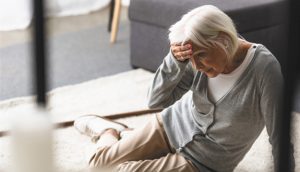By Premier Foot & Ankle Specialists
 Falls are a significant concern to the elderly and pose a public health burden. Annually, falls affect one-third of people over the age of 65. The average age of Venice, FL is 69 years-old so this is a topic that is important in our area. Approximately, 20 percent of fall result in some type of serious injury including hip fractures and death. Multiple factors contribute to imbalance including obvious age-related sensorimotor decline. Some of the other factors are: cognitive impairment, arthritis, chronic neurological disease (for example, neuropathy, diabetes, post-stroke paresis, Parkinson’s disease, multiple sclerosis), lower extremity disabilities, gait disorders and visual impairment. In appropriate footwear also contributes to up to 45% of falls; while among people who suffered a fall-related hi fracture, it was reported 75% were wearing poor footwear at the time of injury. Another study showed that out of 107 people who were admitted to the hospital post fall-related hip fracture, 33% were wearing slippers and 68% were wearing shoes with flexible heel counters at the time of the fracture. Treating these conditions will have a benefit in reducing fall risks but will not totally eliminate falls.
Falls are a significant concern to the elderly and pose a public health burden. Annually, falls affect one-third of people over the age of 65. The average age of Venice, FL is 69 years-old so this is a topic that is important in our area. Approximately, 20 percent of fall result in some type of serious injury including hip fractures and death. Multiple factors contribute to imbalance including obvious age-related sensorimotor decline. Some of the other factors are: cognitive impairment, arthritis, chronic neurological disease (for example, neuropathy, diabetes, post-stroke paresis, Parkinson’s disease, multiple sclerosis), lower extremity disabilities, gait disorders and visual impairment. In appropriate footwear also contributes to up to 45% of falls; while among people who suffered a fall-related hi fracture, it was reported 75% were wearing poor footwear at the time of injury. Another study showed that out of 107 people who were admitted to the hospital post fall-related hip fracture, 33% were wearing slippers and 68% were wearing shoes with flexible heel counters at the time of the fracture. Treating these conditions will have a benefit in reducing fall risks but will not totally eliminate falls.
Identifying and treating patients at risk for falls is a multidisciplinary approach. Podiatrists, physical therapists and primary care physicians should all be part of the treatment team that actively connects with their at-risk patients. Asking about near falls or recent falls is essential since independent seniors may be anxious about divulging their missteps to their medical providers for fear of the repercussions. Podiatric assessment is critical in patients with balance disorders as a study found that 36 percent of seniors in the study had significant foot and leg problems and compromise in balance function. Other studies have linked significant fall risks with foot and ankle problems. These foot and ankle conditions include: peripheral neuropathy, hammertoes, bunions, muscle weakness, tendon contractures, flatfoot and ankle instability. The previous conditions can all be identified and treated by a podiatrist along with identification and education of proper shoe gear.
Treatment programs that educate patients and their family members or caretakers is essential. Eliminating home obstacles and rugs, promoting exercise and strength training, obtaining proper shoe gear and addressing sensorimotor deficits area all crucial. Prescription, casting and fitting of ankle foot orthoses (AFOs) including a Moore Balance Brace can be done by a podiatrist. AFOs for fall prevention have been well documented in elderly patients post-stroke and those with lower extremity conditions and deficits.
Fall risk patients may self-restrict their activities which can lead to further decompensation and deconditioning. For better long-term outcomes, these patient’s need to overcome this loss of confidence. AFOs can help provide a better ambulation and higher quality of life by restoring confidence along with gait speed and functional improvement.
Over the counter AFOs are available but there is evidence that shows custom dynamic (allow motion) AFO devices which maximize arch contour and leg surface area can show immediate clinical improvement. Furthermore, over the counter AFOs are typically static (limit motion) and can potentially cause increased limitations and do not perform well functionally.
Dr. Roggow and Dr. Bonjorno are trained to help prevent complications from falls and correct problems before they arise! We are happily taking new patients, of all types, and look forward to meeting you!
PREMIER FOOT & ANKLE SPECIALISTS
(941) 488-0222
premierfootandanklefl.com
4120 Woodmere Park Blvd, Suite 5, Venice, FL 34293








